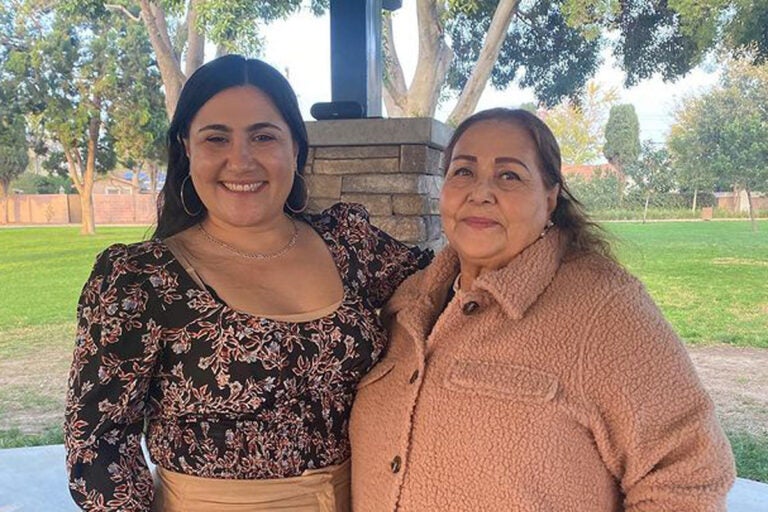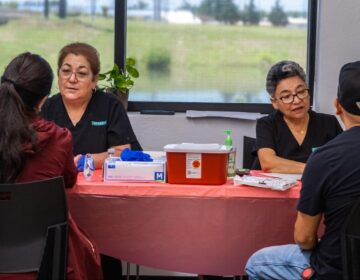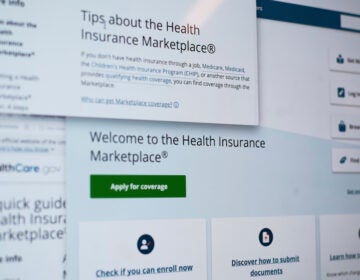Navigating language and cultural barriers to access health care
Although efforts have been made to break down language barriers, many Latino immigrant families rely on younger generations for translation and interpretation.
Listen 17:03
Cynthia Hernandez (left) would help her mother, María de la Paz Hernandez (right), translate and understand important health information. (Courtesy of Cynthia Hernandez)
This story is from The Pulse, a weekly health and science podcast.
Find it on Apple Podcasts, Spotify, or wherever you get your podcasts.
One day, María de la Paz Hernandez went to her doctor’s office to refill her prescription for high blood pressure. Hernandez’s doctor speaks Spanish, her primary language. But during this visit, Hernandez did not speak with her regular doctor. Instead, she spoke with someone else at the clinic and told them in Spanish she was there for a prescription refill.
“Estoy aquí para mi medicina para la presión” or “I’m here for my blood pressure medication,” she told them. At the end of her appointment, Hernandez left with her prescription.
After taking her new medication for a few months, Hernandez felt nauseous, and her hands would get clammy. “It’s these pills — ever since I started taking these pills for my high blood pressure,” she told one of her daughters. Her daughter grabbed the pill canister and googled the name of the prescription. She discovered the medication was not for high blood pressure. It was for antidepressants.
Word about the prescription mix-up had gotten to Cynthia, Hernandez’s youngest daughter who was living in San Francisco at the time. Cynthia understood her parent’s health care situation. Growing up, she translated and explained their health insurance documents because English wasn’t their first language.
So, Cynthia asked her mother how she ended up with antidepressants. Hernandez wasn’t sure, only that she asked for her medication with someone that didn’t speak Spanish.
‘“Para la presión,”’ she repeated to Cynthia. After hearing this, Cynthia realized the mistake. The clinician must have misinterpreted “la presión” which is pressure for “depresíon” which means depression.
Hernandez felt bad and blamed herself, but Cynthia knew this wasn’t her mother’s fault.
“She was given the wrong medication not because of her. It was because of negligence at the medical practice,” Cynthia said.
Subscribe to The Pulse
Language barriers like these can lead to serious medical mistakes. They’re also hurdles for people who don’t speak English efficiently trying to access basic health care.
In 2021, The Department of Health and Human Services reported on challenges Latinos in the country face trying to access health care. One of those challenges in the report was language barriers and cultural competency. In states like California with a large share of the country’s Latino population, over a quarter speak Spanish at home. And almost a fifth of them have reported not being able to speak English very well.
Cynthia’s parents immigrated to the U.S. in the 70s and met at a factory that made fabric swatches in downtown Los Angeles. They settled in Bell, a city in Southeast Los Angeles County with a large Latino population. When Cynthia and her siblings were kids, their parents didn’t have a hard time communicating with doctors.
That’s because most of the clinics in Bell have Spanish speaking clinicians. But research shows that as the Latino population continues to increase in California, the number of Latino physicians who are culturally competent and speak Spanish is not meeting the demand. Arturo Vargas Bustamante, a health policy professor at UCLA’s School of Public Health, co-authored a report on this issue, The Latino Physician Crisis.
“Given that the numbers are not that high, then the probability that someone who will be Latino and be able to communicate in Spanish serving in these communities is gonna be lower,” Vargas Bustamante said.
According to data from the California Health Interview Survey, about 6.5% of adults living in Bell and the surrounding neighborhood who do not speak English “very well” reported that they had difficulty understanding their doctor.
Many immigrant families like Cynthia’s, have relied on their family members for translation or Spanish speaking staff who aren’t certified interpreters. Experts in family medicine strongly discourage this and say speaking the language is not enough and for providers to refer to a medical interpreter if they’re not confident.
Federal and state laws grant patients the right to a medical interpreter through their health plan or medical provider. In the event of a medical mistake, patients are also encouraged to file a complaint with their provider or a health care agency like California’s Department of Managed Health Care.
The DMHC regulates most health plans in California for more than 28 million people. It also has a hotline for patients to ask basic questions about their health plan. “Health care is really complicated. And particularly for those that are non-English speakers, they may just not know that this is something they’re entitled to or that we’re available to help,” said Mary Watanabe, Director of the DMHC.
Experts in family medicine advise that limited English-speaking patients must become advocates for their own health care. Cynthia believes her parents learned this the hard way and in turn changed their perspective of the health care system. “She and my dad became very vigilant when it came to their health. It made them stronger advocates for themselves.”
Editor’s note: The reporter wanted to interview María de la Paz Hernandez for this story, but she and her husband, Adalberto, died unexpectedly in a car accident on October 8, 2022.
Support for WHYY’s coverage of health equity issues comes from the Commonwealth Fund.
WHYY is your source for fact-based, in-depth journalism and information. As a nonprofit organization, we rely on financial support from readers like you. Please give today.






